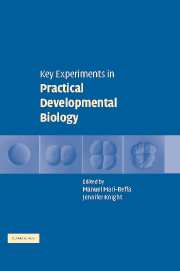Book contents
- Frontmatter
- Contents
- List of contributors
- Preface
- Introduction
- SECTION I GRAFTINGS
- SECTION II SPECIFIC CHEMICAL REAGENTS
- SECTION III BEAD IMPLANTATION
- SECTION IV NUCLEIC ACID INJECTIONS
- 9 RNAi techniques applied to freshwater planarians (Platyhelminthes) during regeneration
- 10 Microinjection of Xenopus embryos
- SECTION V GENETIC ANALYSIS
- SECTION VI CLONAL ANALYSIS
- SECTION VII IN SITU HYBRIDIZATION
- SECTION VIII TRANSGENIC ORGANISMS
- SECTION IX VERTEBRATE CLONING
- SECTION X CELL CULTURE
- SECTION XI EVO–DEVO STUDIES
- SECTION XII COMPUTATIONAL MODELLING
- Appendix 1 Abbreviations
- Appendix 2 Suppliers
- Index
- Plate Section
- References
9 - RNAi techniques applied to freshwater planarians (Platyhelminthes) during regeneration
Published online by Cambridge University Press: 11 August 2009
- Frontmatter
- Contents
- List of contributors
- Preface
- Introduction
- SECTION I GRAFTINGS
- SECTION II SPECIFIC CHEMICAL REAGENTS
- SECTION III BEAD IMPLANTATION
- SECTION IV NUCLEIC ACID INJECTIONS
- 9 RNAi techniques applied to freshwater planarians (Platyhelminthes) during regeneration
- 10 Microinjection of Xenopus embryos
- SECTION V GENETIC ANALYSIS
- SECTION VI CLONAL ANALYSIS
- SECTION VII IN SITU HYBRIDIZATION
- SECTION VIII TRANSGENIC ORGANISMS
- SECTION IX VERTEBRATE CLONING
- SECTION X CELL CULTURE
- SECTION XI EVO–DEVO STUDIES
- SECTION XII COMPUTATIONAL MODELLING
- Appendix 1 Abbreviations
- Appendix 2 Suppliers
- Index
- Plate Section
- References
Summary
OBJECTIVE OF THE EXPERIMENT The mechanisms that silence unwanted gene expression are critical for normal cellular function. Double-stranded RNA (dsRNA) induces gene silencing by the degradation of single-stranded (ssRNA) targets complementary to the dsRNA trigger. RNA interference (RNAi) effects activated by dsRNA have been demonstrated in a number of organisms including plants, protozoa, hydra, planarians, nemertines, annelids, nematodes, insects and mammals. In this experiment, we aim to introduce a methodology to produce and visualize the loss of function phenotype of dsRNA-injected planarians. In this experiment, two genes will be silenced by post-transcriptional gene silencing: Gtsix-1, a gene involved in the determination of the eye field and eye formation, and Tcen49, an invertebrate trophic factor involved in regional cell survival.
To achieve Six/tcen49 loss-of-function, several procedures will be used:
plasmid linearization
ribosynthesis
dsRNA production
dsRNA delivery by microinjection
DEGREE OF DIFFICULTY This experiment is moderately difficult. It requires some skills in ribosynthesis and microinjection, and the use of appropriate materials.
INTRODUCTION
Platyhelminthes are acoelomate members of the Bilateria, which share with other phyla like Gastrotricha and Acanthocephala a basal position in the Lophotrochozoa clade (Aguinaldo et al., 1997). Planarians (order Tricladida) are free-living platyhelminthes, well known for their ability for regeneration (Baguñà, 1998; Saló and Baguñà, 2002), which can be easily triggered by amputation of body fragments. In addition to the regenerative capacity of the planarian body, its morphological simplicity, which nevertheless includes all the basic characteristics of a bilaterian representative – cephalization, dorso–ventral and antero–posterior polarity – makes it a useful model for investigating the evolution of molecular developmental processes.
- Type
- Chapter
- Information
- Key Experiments in Practical Developmental Biology , pp. 106 - 116Publisher: Cambridge University PressPrint publication year: 2005



